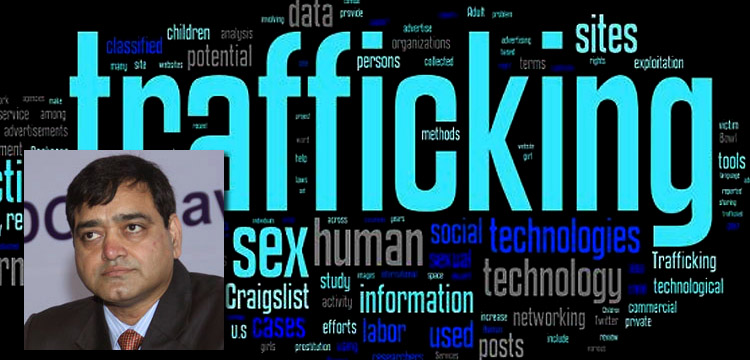This article was first published in Live Encounters Magazine, Volume One, December 2015. In this issue of Live Encounters Magazine, in celebration of our 7th year, we republish this piece as a reminder to our readers of the importance of fighting the scourge of human trafficking that has grown to alarming proportions.
Combating Human Trafficking: Gaps in Policy and Law by Dr Veerendra Mishra. Published by SAGE.
Veerendra Mishra is currently working as Executive Director of Nehru Yuva Kendra Sangathan, an Autonomous body under Ministry of Youth Affairs and Sports. Previously, he was Assistant Inspector General (CID) with Madhya Pradesh police. He did his PhD on ‘Changing Image of Police: An Empirical Study’ from Barkatullah University, Bhopal in 2004. Dr Mishra has extensively studied the workings of police—both local police bodies and international bodies such as the United Nations Police (UNPOL). He has been awarded the prestigious Hubert Humphrey Fellowship under Fulbright Scholarship on the subject of HT. He served in two UN Missions in Bosnia and Kosovo. He stayed in East Timor for five months and was instrumental in preparing training module for community policing training to community members of the country, as pro-bono consultant of Asia Foundation. Mishra was nominated for the Indira Gandhi Communal Harmony Award in 2008. He writes on varied subjects, fiction and professional. He has published a short story book, stories in “Chicken Soup Soul” series and a book entitled, Community Policing: Misnomer or Fact.
—————————–
Preface©
Give me few men and women who are pure and selfless and I shall shake the world.
Swami Vivekanand
Human trafficking is referred to differently in different regions of the globe. USA refers it as Trafficking in Persons (TIP) and European countries prefer to call it Trafficking in Human Beings (THB). The general term is human trafficking. This book is very flexible and has used the terms interchangeably. Interestingly, in Hindi (India), human trafficking is referred as manav durvyapar, which literally would mean “illegal trading of humans,” though this would not construe human trafficking as per definition because of ambiguity in purpose. However, this is the closest workable term in vogue, and to make it more specific, it would be better to qualify the purpose of illegal trade, that is, manav durvyapar, for exploitation.
This book deals with the legal, functional, and technical part of human trafficking. Human trafficking, as a subject of study, has evolved very recently or, to be honest, is still evolving. There are still gaps in under-standing of what action is construed as trafficking worldwide. Despite the fact that more than 13 years back, United Nations (UN) defined human trafficking in its Palermo Protocol, but still there are countries which have not framed laws to address it. Trafficking, per se, has not even found space in the law books of many countries. Even USA, which has been releasing TIP report for more than a decade now, ranking 184 nations, does not accept the UN definition in totality. In the definition given in Trafficking Victims Protection Act 2000, which has been reauthorized every three years, latest in 2013, talks merely about forced labor and sex trafficking, overlooking trafficking for organ transplant, which is mentioned in UN definition. There are many more dimensions of trafficking, which are not covered in UN definition; hence, this book has raised the issues of revisiting the definition. USA has found an easy way out by generalizing the term forced labor and claiming to encompass all other dimensions, which they fail to recognize or will be realized later. However, this book also mentions the practical risk involved in over generalization of terms.
To address the problem of human trafficking, it is necessary that we try to understand the various dimensions of trafficking. And each dimension has to be further classified to comprehend the basic difference, or else the strategy to counter trafficking, through legal or social means, will misfire. This book has tried to discuss in detail the possibly known dimensions with classifications.
A new addition to the most often discussed dimension is medical trafficking, which goes beyond trafficking for organ transplant, such as trafficking for surrogacy and clinical drug trials. Attempts have been made to specify dimensions, in contradiction to the popular US belief of considering all forms of trafficking under forced labor.
There are various perspectives on human trafficking as to whether to consider it as a legal problem or a social problem. Depending on perception of the policy makers, legislations are framed to address the problem. In the past, it was considered to be purely a law enforcement problem, but of late with the development of a concept of victim protection, there is a perceptible shift in approach, particularly among civil society organizations (CSOs) in Western countries. The book tries to analyze various perspectives and possible convergence for holistic address of the issue.
The book adds new perspective to the subject of trafficking by analyzing the gaps in social policies, which have resulted in continuous increase in human trafficking. The discussion ranges from understanding the criminal justice system, its merger with social justice system, and the new progressive shift in legislations in the form of socio-criminal acts. Brute Mute theory, developed over the concept of unheard stifled voices of vulnerable, who are supposed to be the main benefactors of any social policy but land up being victims of unfair social justice system, explains the practical gaps in framing and implementation of social policies and legal acts. A study of two communities, Bedia in India and the Native Americans in USA, reflects the above-mentioned gaps, enhancing their vulnerability.
Here, I would like to humbly submit that this is not a book on human trafficking laws. The reference of laws is a natural consequence of any discussion on human trafficking. As the title of the book suggests, this is a book on gaps in social policies and legal acts, which are the causes of perpetuation of human trafficking.
© Dr Veerendra Mishra/SAGE Publications


